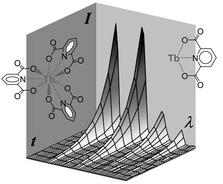Medium effects on the photophysical properties of terbium(iii) complexes with pyridine-2,6-dicarboxylate†
Abstract
Emission quantum yields and excited-state lifetimes of mono-, bis- and tris-complexes of terbium(III) with pyridine-2,6-dicarboxylate (DPA) have been measured for aqueous solutions as a function of pH and in the presence of six different anions: bromide, chloride, sulfate, perchlorate, acetate and nitrate. The state of ligation of the terbium ion had a more dramatic effect on photophysical properties of the complexes in comparison with the alteration of other medium parameters. An increase in the number of DPA ligands, coordinated with Tb3+ (from zero to three) resulted in an increase in the emission quantum yield from 0.06 to ∼0.4, with concurrent prolongation of the excited-state lifetime from 0.5 to ∼2 ms. It was determined that both an increase in the non-radiative decay rates and a decrease in the values of the radiative decay rate constants, contribute to the luminescence quenching that was detected when the number of DPA ligands was decreased and/or the media acidified. The purpose of this investigation is to aid in the establishment of optimal conditions for conducting terbium(III)-based emission assays for DPA, which is found in the coats of endospores.


 Please wait while we load your content...
Please wait while we load your content...